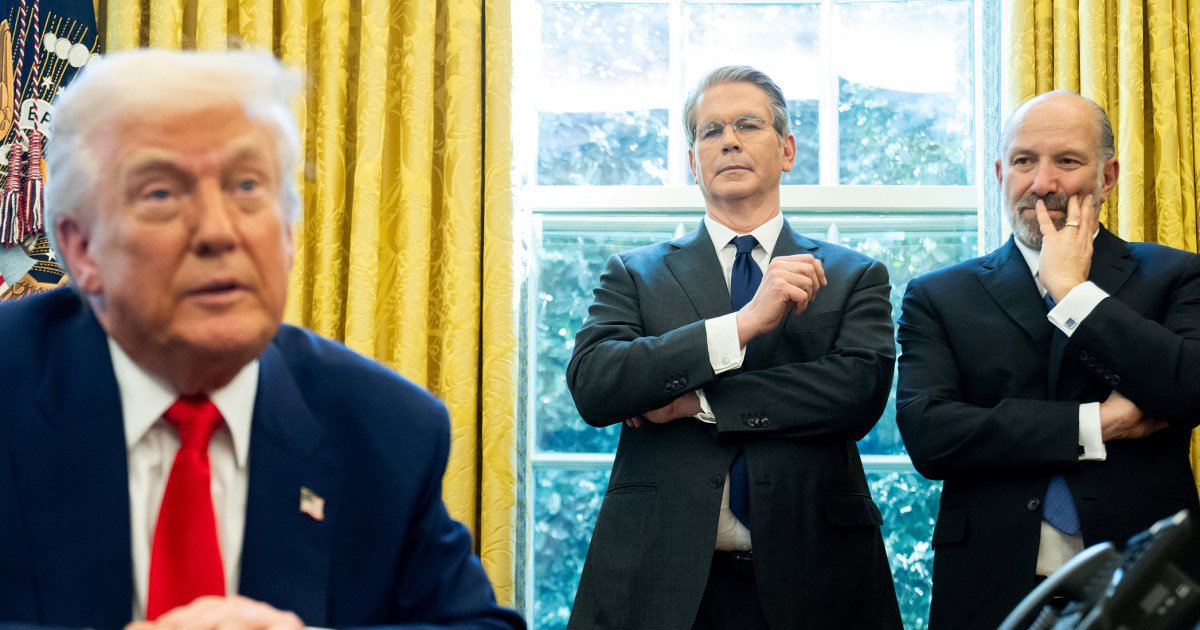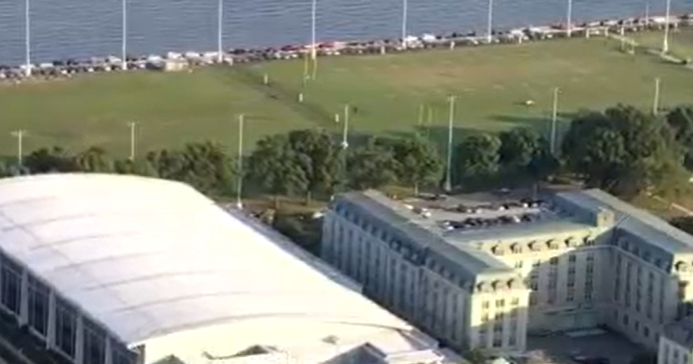Top Stories
Trump’s tariffs face crucial court test on eve of latest deadline

President Donald Trump’s global tariff regime heads to court Thursday in a fight for its survival.
Starting at 10 a.m. ET, a panel of 11 judges in Washington, D.C., will hear about 45 minutes of arguments each from the Trump administration and two small businesses that say many of his import duties are illegal.
Trump’s sweeping tariffs are set to go into effect Friday. Since he postponed the biggest hikes in April because of market turmoil, Trump has announced an array of tariff levels with about a dozen trading partners. Many of them closely resemble the rates Trump threatened to impose in early April, although some are higher and a few are slightly lower.
Businesses of every size have said tariffs have caused confusion and uncertainty and have made it extremely difficult to plan. “Retailers typically plan their inventories six to nine months in advance to meet seasonal demand. However, unpredictable and rapidly changing tariff policies are making it nearly impossible to forecast costs, place orders and manage supply chains effectively,” the National Retail Federation said in June.
V.O.S. Selections Inc., a wine and spirits importer, and Plastic Services and Products, a pipe and fittings company, sued Trump over his use of the International Emergency Economic Powers Act (IEEPA) of 1977, saying he has “no authority to issue across-the-board worldwide tariffs without congressional approval.”
The Court of International Trade initially blocked the tariffs in late May. It found that the import duties lacked “any identifiable limits” and that the law Trump cited in many of his executive orders did not “delegate an unbounded tariff authority to the President.” It also said the tariffs did not meet the test of an “unusual and extraordinary” risk to the country.
All of Trump’s tariffs on major trading partners, such as Canada, Mexico, China, the European Union, Japan, India, Brazil and a handful of other countries, have been deployed using the law.
“Congress has not delegated any such power,” the companies’ initial legal filing said. “And the President’s justification does not meet the standards set forth in the IEEPA. His claimed emergency is a figment of his own imagination: trade deficits, which have persisted for decades without causing economic harm, are not an emergency.”
“IEEPA nowhere mentions tariffs, duties, imposts, or taxes, and no other President in the statute’s nearly 50-year history has claimed that it authorizes tariffs,” the companies added in a filing with the appeals court.
The White House said in May about the case that trade deficits “have created a national emergency that has decimated American communities, left our workers behind, and weakened our defense industrial base.”
The court battle would not affect tariffs Trump implemented under other laws, such as 10% steel tariffs on the United Kingdom and 50% steel and aluminum tariffs on all other worldwide trading partners. Those tariffs were implemented under various sections of the Trade Act of 1974 and the Trade Expansion Act of 1962.
The companies also argue that such sweeping tariffs would be “devastating” to small businesses across the United States.
The panel of judges is not expected to rule this week. Regardless of the outcome, the losing party is likely to appeal to the Supreme Court, and the lingering uncertainty that has kept consumers and businesses in a bind for the better part of this year could remain.
The lawsuit is not the only challenge Trump’s tariffs and trade deals face, either. There are at least a dozen other lawsuits filed or in the early stages of being heard by courts.
In a similar lawsuit filed this month, an orange juice importer warned that the price of its products could soar as much as 25% for U.S. consumers. Trump said he would hit Brazil with 50% tariffs, citing a trade deficit that is actually a surplus. But Trump’s extraordinarily high levy is primarily due to the treatment of a political ally, former Brazilian President Jair Bolsonaro, and the treatment of tech companies — notably Elon Musk’s X.
Even if the court rules that Trump’s tariffs are illegal and blocks them, there are still a few other avenues the administration could take to keep them in place.
Trump could instruct the commerce secretary and the U.S. trade representative to launch investigations under Section 301 of the 1974 U.S. Trade Act against various trading partners, which would allow tariffs to be implemented after an investigation runs its course. Trump could also use Section 232 of the 1962 trade law, which he is already using for steel and aluminum duties.
Then, there is a never-before-used trade law. “Section 338 of the Trade Act of 1930 allows the President to impose tariffs of up to 50% on imports from countries that discriminate against the US,” Goldman Sachs’ chief U.S. political economist, Alec Phillips, said in a statement.
“This authority, which has never been used … limits the amount of the tariffs but does not require a formal investigation,” Phillips said.
In an essay on trade issues, Max Yoeli, a senior fellow at the U.K. think tank Chatham House, and Leslie Vinjamuri the president and CEO of the Chicago Council on Global Affairs, note that Trump could also “work with Congress to pass new legislation underpinning additional tariff authorities, but his administration has shown a strong preference for executive action to date.”
“The president has many other tools to coerce states and pursue his objectives, including expanding his use of sanctions and export controls,” they wrote.
Trump could also negotiate and agree to formal trade deals. So far, though, most of what he and his administration have called deals are not full-fledged pacts. Instead, they are framework agreements light on details announced on social media followed by slim executive orders.
However, formal trade deals typically take years to reach because of the highly complex nature of the U.S. and global economies. The United States alone has more than 12,000 possible tariff categories among 200 trading partners, according to the financial services firm UBS.
Congress could approve any formal trade deal without a court’s intervening.
CORRECTION (July 31, 8:31 a.m. ET): A previous version of this article incorrectly identified where a federal appeals court panel would hear arguments Thursday. It is in Washington, D.C., not New York.
Top Stories
Packers defeat Commanders, 27-18, on Thursday Night Football

Packers dispatch Commanders 27-18, improve to 2-0
Parsons blew through a Josh Conerly Jr. block and Jeremy McNichols chip to flush Daniels from the pocket and into a 1-yard run. Washington responded with an 11-yard pass to McLaurin on third-and-9 and a Zach Ertz score off a 20-yard touchdown pass to make it 17-10 Packers with 13:45 remaining.
Green Bay opened with an 11-yard pass to Wicks on an out after coming across in motion. A holding penalty on Marshon Lattimore moved Green Bay across midfield.
On third-and-6, Kraft fought through illegal contact by Commanders safety Will Harris to pick up eight yards to the Washington 37 on a pass from Love.
Green Bay motioned Williams to the backfield on second-and-8 and he took a direct snap and ran the ball 16 yards to the Washington 19. Matthew Golden gained nine yards on a sweep on the next play.
On first-and-goal, Washington bit hard on the play fake to Jacobs and Kraft came free for an 8-yard touchdown to make it 24-10 Packers with 8:57 remaining.
Green Bay’s defense got a four-and-out on its next stand with Quay Walker hitting Daniels on third-and-4 to force and incompletion and Nixon getting his fourth breakup of the evening to give the offense the ball back at the Washington 41.
The Packers picked up two yards on a Jacobs run before McManus made a 56-yard field goal to push Green Bay’s lead to 27-10 with 6:42 remaining. That field goal ties Mason Crosby for longest make in a regular-season game by a Packers player.
Washington moved the ball down the field while Green Bay was playing prevent on its next series, with Nixon registering his fifth breakup.
The Commanders reached the end zone on a 10-yard slant to Samuel for a touchdown with 2:53 left. Daniels converted the two-point conversion with a pass to Luke McCaffrey, cutting the Packers’ lead to 27-18.
Wicks recovered the onside kick at the Green Bay 48. Love was sacked for a 13-yard loss on second down and Jacobs gained 10 back on third-and-21 as the game reached the two-minute warning.
Washington took over at its 20 with 1:47 remaining and no timeouts. The Commanders gained 13 yards before turning the ball over on downs and the Packers kneeled out the win.
Top Stories
Packers deliver statement win over Commanders behind Jordan Love, Micah Parsons, Tucker Kraft

If the Packers used a Week 1 domination of the Lions as a major statement, they backed it up and then some in Week 2. The Packers (2-0) defeated the Commanders (1-1), 27-18, fueled by an explosive, efficient offense and a tremendous defense that seemed to move at a completely different speed than Washington’s offense.
Love finished with 292 yards passing and a pair of touchdowns, with six completions for 124 yards and a score going to Kraft. Micah Parsons officially recorded a half-sack, but his impact was much larger than that, and Green Bay sacked Jayden Daniels four times while smothering would-be pass catchers.
After a slow start — Jayden Reed’s shoulder injury being the main development — Green Bay’s offense got rolling on its second drive, fueled by a 57-yard completion from Love to Kraft after Kraft broke free down the middle. Love connected with Romeo Doubs for a 5-yard touchdown shortly thereafter.
Washington did not manage a single first down in the first quarter — a first since Daniels’ arrival — and Green Bay embarked on another long drive early in the second quarter, highlighted by a remarkable, twisting 37-yard catch from Malik Heath.
Josh Jacobs powered in from two yards out to make it 13-0. Commanders defensive lineman Deatrich Wise Jr. got carted off after trying to block the extra point (which was successful), adding to Washington’s woes. He was later ruled out with a quad injury.
Washington finally got on the board with a 51-yard Matt Gay field goal, but Gay missed a 58-yarder that could have cut the deficit further just before the half. But Green Bay’s Brandon McManus then doinked a 48-yard try as time expired.
Down 17-3 after a McManus field goal, Washington finally found the end zone via a 20-yard Zach Ertz catch-and-run. Green Bay answered, though, with another touchdown drive, this one capped by Love’s 8-yard touchdown toss to Kraft.
McManus nailed a 56-yard field goal shortly thereafter to extend the lead to three scores. Daniels found Deebo Samuel Sr. for a touchdown late, but it proved to be only window dressing — and a costly one at that: Austin Ekeler suffered a non-contact Achilles injury and was carted off the field.
Washington will hope to use the mini-bye to recuperate before hosting the Raiders in Week 3. Green Bay will hope to carry momentum over to a Week 3 visit to the Browns.
Top Stories
1 injured while U.S. Naval Academy building was cleared after reported threat

A person was injured while a building was being cleared Thursday afternoon at the U.S. Naval Academy in Annapolis, according to the Naval Support Activity Annapolis.
Maryland Congresswoman Sarah Elfreth said a midshipman was injured.
The campus was on lockdown following reports of threats, the academy said. The NSA said the reports were of suspicious activity on the Naval Academy grounds.
“Our Midshipmen are our best and brightest young Americans, and like all students, they deserve to feel safe on campus,” Rep. Elfreth said. “Thankfully, the Midshipman who was injured during the clearing of a building is in stable condition.”
Navy officials said there was no active shooter threat. However, a person was injured when Naval Security Forces were clearing a building on campus. The person was flown by medevac to a hospital.
Police presence was seen around Bancroft Hall, a large residence hall on campus that houses 1,600 midshipmen.
“The base is on lockdown out of an abundance of caution,” a U.S. Naval Academy spokesperson said. “This is a developing situation, and we will provide updates as they become available.”
The governor’s office says there is no credible threat at the U.S. Naval Academy.
“Absolutely terrifying,” said Annapolis resident Anne Lillefloren. “You are thinking, ‘Oh my gosh, I know students there, I know staff there. I walk around the academy almost every morning with my dad. So everyone who comes in contact, you’re thinking. ‘Oh, who could be there? Who could this reach? Just panic, and in today’s climate, what can happen, all of these false reports, so you don’t know what the truth is.”
-

 Business2 weeks ago
Business2 weeks agoThe Guardian view on Trump and the Fed: independence is no substitute for accountability | Editorial
-
Tools & Platforms1 month ago
Building Trust in Military AI Starts with Opening the Black Box – War on the Rocks
-

 Ethics & Policy2 months ago
Ethics & Policy2 months agoSDAIA Supports Saudi Arabia’s Leadership in Shaping Global AI Ethics, Policy, and Research – وكالة الأنباء السعودية
-

 Events & Conferences4 months ago
Events & Conferences4 months agoJourney to 1000 models: Scaling Instagram’s recommendation system
-

 Jobs & Careers2 months ago
Jobs & Careers2 months agoMumbai-based Perplexity Alternative Has 60k+ Users Without Funding
-

 Podcasts & Talks2 months ago
Podcasts & Talks2 months agoHappy 4th of July! 🎆 Made with Veo 3 in Gemini
-

 Education2 months ago
Education2 months agoMacron says UK and France have duty to tackle illegal migration ‘with humanity, solidarity and firmness’ – UK politics live | Politics
-

 Education2 months ago
Education2 months agoVEX Robotics launches AI-powered classroom robotics system
-

 Funding & Business2 months ago
Funding & Business2 months agoKayak and Expedia race to build AI travel agents that turn social posts into itineraries
-

 Podcasts & Talks2 months ago
Podcasts & Talks2 months agoOpenAI 🤝 @teamganassi

